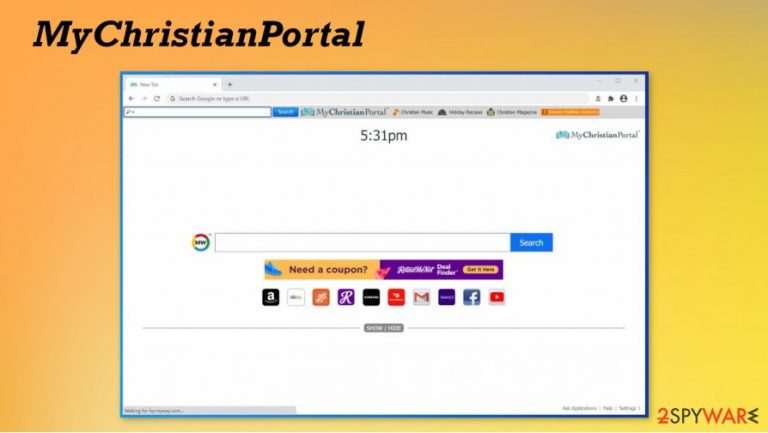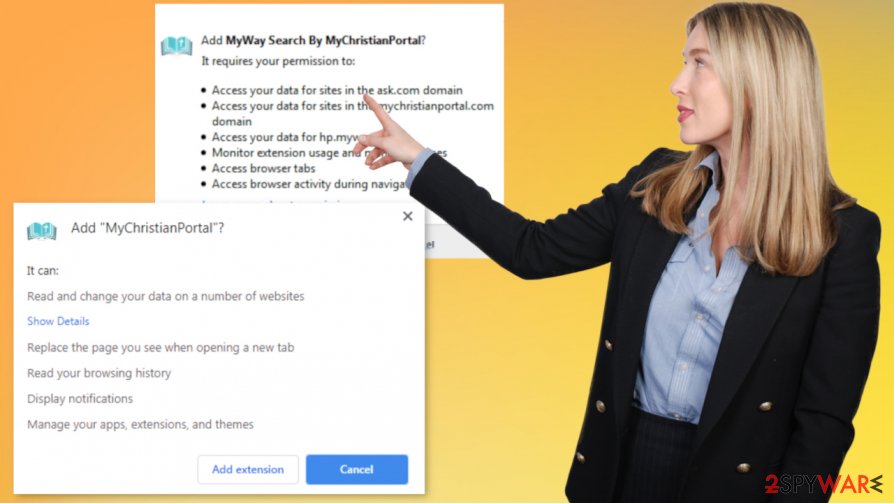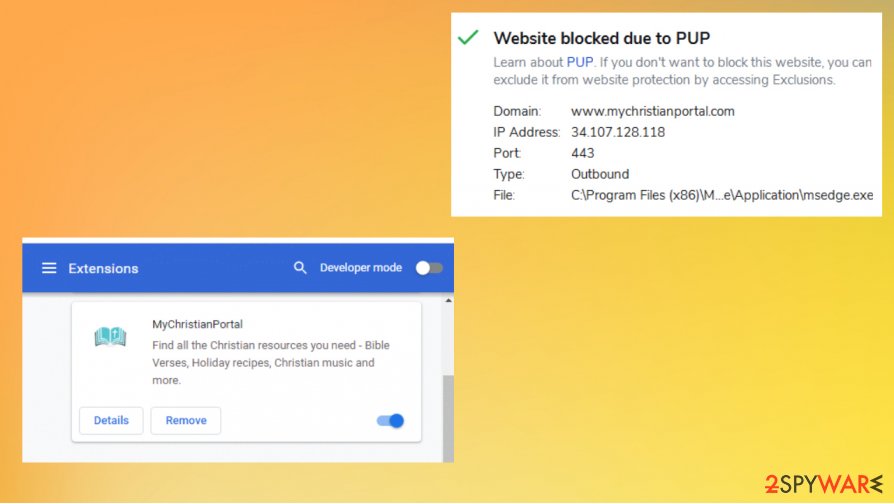MyChristianPortal (Free Instructions) - Removal Guide
MyChristianPortal Removal Guide
What is MyChristianPortal?
MyChristianPortal is the search hijacker that triggers issues with settings and preferences of the web browser

MyChristianPortal is the search engine that takes over the browser, so the third-party content gets delivered to the screen. It manipulates the browser to change the start page, new tab settings, and reroute every online search through the same engine that delivers results injected with advertisements, other commercial content. This is the Mindspark/Ask application family members. The potentially unwanted program that affects time online significantly only with those alterations done on the browser. This browser hijacker affects time online directly, and can trigger installations of other apps, browser-based content, redirect to commercial sites, show possibly malicious material. You need to react to these changes and strange activities, so you can clean the machine properly.
| Name | MyChristianPortal |
|---|---|
| Type | Browser hijacker |
| Distribution | Software bundle packages, deceptive ads, fake update prompts can lead to the installation of such PUPs. Users also can install the toolbar/ browser application on purpose by falling for the promotional advertisements |
| Symptoms | Unknown extension or application is installed on the system; homepage and new tab address are set to something else; a customized search engine is appended to the homepage; search results are filled with sponsored links and ads |
| Risks | Installation of other potentially unwanted programs, privacy risks due to information gathering practices, financial losses[1] |
| Removal | You can remove MyChristianPortal by running a proper system scan using an anti-malware tool that detects and terminates the PUP properly |
| Optional steps | Computer infections can cause significant damage to system files or disrupt normal settings. To repair the OS, perform a scan with FortectIntego or another system optimizer/ repair software |
MyChristianPortal should be helpful and provide various Christian sources for the user, so it might trick people into installing the program on the browser or the computer directly. There are no valuable features, however. This is the browser hiajcker[2] that is focused to alter search results. That's all.
MyChristianPortal virus is not the term for this application, but users tend to call the application like that due to intrusive and annoying behavior. This program gets to access settings on your browser and machine in general. After the installation, it also can change those preferences automatically without additional permissions needed. Pay attention to these issues.
MyChristianPortal is the same as other sites and browser hijackers from the same developer: My Forms Finder; Totalrecipesearch; Maps Galaxy; MyScrapNook Toolbar; Pets by MyWay, Wallpaper by MyWay; EasyDirectionsFinder Toolbar; QuickWeatherAlert Toolbar.
These browser search engines or tools lead all the queries through the engine based on Hp.myway.com. This is why you can spot that the default search on the browser is set to My Way Search. MyChristianPortal can initiate other automatic installations of programs that further affect the performance and security of the machine.

You should remove MyChristianPortal as soon as you can because the longer potentially unwanted program gets to run on the system, the more issues it can trigger. You should pay attention to details and find the best tool for threat elimination. It is not recommended by experts[3] to do it manually, so rely on SpyHunter 5Combo Cleaner or Malwarebytes for this.
It can be difficult to achieve the best results of cleaning the machine if you try to perform MyChristianPortal removal yourself. You cannot find all PUPs and related files that get added behind your back. An automatic system scan can find all the possible threats and remove them properly.
Then you have to repair parts that get damaged by the intruder. It is known that adware, browser hijackers, general PUPs like MyChristianPortal all can trigger changes in settings, direct alterations to programs, and web browsers like Google Chrome, Internet Explorer, Mozilla Firefox, or Safari. Run FortectIntego for the system and file issue fix.

Freeware installations lead to unwanted app downloads
Internet is full of questionable content, including deceptive pages, ads, and other material that leads to issues with the machine, security, if the computer. You can end up on a free download site and get a program added to the computer without even noticing.
In most cases, pop-ups that promote updates or installations of additional pieces only need some interaction from you, so the automatic procedure is launched. Of course, there are particular PUP distribution methods like software bundling that can lead to undisclosed application downloads. Go for Advanced or Custom options to avoid that.
Make sure to remove MyChristianPortal virus from the system properly
You can be concerned about the behavior of the potentially unwanted program. It can run in the background and trigger unwanted changes. It is important to note that browser hijacker is intrusive and related to other PUPs. Remove MyChristianPortal as soon as you notice any suspicious activities and make sure to clear the damage too.
Even though this is not a virus or malicious program, various changes that hijacker creates can affect the success of MyChristianPortal removal. Rely on anti-malware tools, so the machine gets fully checked, and all the intruders terminated. Then, you can reset browsers and recover system damage, altered files, corrupted programs.
You may remove virus damage with a help of FortectIntego. SpyHunter 5Combo Cleaner and Malwarebytes are recommended to detect potentially unwanted programs and viruses with all their files and registry entries that are related to them.
Getting rid of MyChristianPortal. Follow these steps
Uninstall from Windows
Remove MyChristianPortal by running theses steps
Instructions for Windows 10/8 machines:
- Enter Control Panel into Windows search box and hit Enter or click on the search result.
- Under Programs, select Uninstall a program.

- From the list, find the entry of the suspicious program.
- Right-click on the application and select Uninstall.
- If User Account Control shows up, click Yes.
- Wait till uninstallation process is complete and click OK.

If you are Windows 7/XP user, proceed with the following instructions:
- Click on Windows Start > Control Panel located on the right pane (if you are Windows XP user, click on Add/Remove Programs).
- In Control Panel, select Programs > Uninstall a program.

- Pick the unwanted application by clicking on it once.
- At the top, click Uninstall/Change.
- In the confirmation prompt, pick Yes.
- Click OK once the removal process is finished.
Delete from macOS
Remove items from Applications folder:
- From the menu bar, select Go > Applications.
- In the Applications folder, look for all related entries.
- Click on the app and drag it to Trash (or right-click and pick Move to Trash)

To fully remove an unwanted app, you need to access Application Support, LaunchAgents, and LaunchDaemons folders and delete relevant files:
- Select Go > Go to Folder.
- Enter /Library/Application Support and click Go or press Enter.
- In the Application Support folder, look for any dubious entries and then delete them.
- Now enter /Library/LaunchAgents and /Library/LaunchDaemons folders the same way and terminate all the related .plist files.

Remove from Microsoft Edge
Delete unwanted extensions from MS Edge:
- Select Menu (three horizontal dots at the top-right of the browser window) and pick Extensions.
- From the list, pick the extension and click on the Gear icon.
- Click on Uninstall at the bottom.

Clear cookies and other browser data:
- Click on the Menu (three horizontal dots at the top-right of the browser window) and select Privacy & security.
- Under Clear browsing data, pick Choose what to clear.
- Select everything (apart from passwords, although you might want to include Media licenses as well, if applicable) and click on Clear.

Restore new tab and homepage settings:
- Click the menu icon and choose Settings.
- Then find On startup section.
- Click Disable if you found any suspicious domain.
Reset MS Edge if the above steps did not work:
- Press on Ctrl + Shift + Esc to open Task Manager.
- Click on More details arrow at the bottom of the window.
- Select Details tab.
- Now scroll down and locate every entry with Microsoft Edge name in it. Right-click on each of them and select End Task to stop MS Edge from running.

If this solution failed to help you, you need to use an advanced Edge reset method. Note that you need to backup your data before proceeding.
- Find the following folder on your computer: C:\\Users\\%username%\\AppData\\Local\\Packages\\Microsoft.MicrosoftEdge_8wekyb3d8bbwe.
- Press Ctrl + A on your keyboard to select all folders.
- Right-click on them and pick Delete

- Now right-click on the Start button and pick Windows PowerShell (Admin).
- When the new window opens, copy and paste the following command, and then press Enter:
Get-AppXPackage -AllUsers -Name Microsoft.MicrosoftEdge | Foreach {Add-AppxPackage -DisableDevelopmentMode -Register “$($_.InstallLocation)\\AppXManifest.xml” -Verbose

Instructions for Chromium-based Edge
Delete extensions from MS Edge (Chromium):
- Open Edge and click select Settings > Extensions.
- Delete unwanted extensions by clicking Remove.

Clear cache and site data:
- Click on Menu and go to Settings.
- Select Privacy, search and services.
- Under Clear browsing data, pick Choose what to clear.
- Under Time range, pick All time.
- Select Clear now.

Reset Chromium-based MS Edge:
- Click on Menu and select Settings.
- On the left side, pick Reset settings.
- Select Restore settings to their default values.
- Confirm with Reset.

Remove from Mozilla Firefox (FF)
Reset the browser, so all shady apps get terminated
Remove dangerous extensions:
- Open Mozilla Firefox browser and click on the Menu (three horizontal lines at the top-right of the window).
- Select Add-ons.
- In here, select unwanted plugin and click Remove.

Reset the homepage:
- Click three horizontal lines at the top right corner to open the menu.
- Choose Options.
- Under Home options, enter your preferred site that will open every time you newly open the Mozilla Firefox.
Clear cookies and site data:
- Click Menu and pick Settings.
- Go to Privacy & Security section.
- Scroll down to locate Cookies and Site Data.
- Click on Clear Data…
- Select Cookies and Site Data, as well as Cached Web Content and press Clear.

Reset Mozilla Firefox
If clearing the browser as explained above did not help, reset Mozilla Firefox:
- Open Mozilla Firefox browser and click the Menu.
- Go to Help and then choose Troubleshooting Information.

- Under Give Firefox a tune up section, click on Refresh Firefox…
- Once the pop-up shows up, confirm the action by pressing on Refresh Firefox.

Remove from Google Chrome
Recover from MyChristianPortal infection by restoring Chrome to default
Delete malicious extensions from Google Chrome:
- Open Google Chrome, click on the Menu (three vertical dots at the top-right corner) and select More tools > Extensions.
- In the newly opened window, you will see all the installed extensions. Uninstall all the suspicious plugins that might be related to the unwanted program by clicking Remove.

Clear cache and web data from Chrome:
- Click on Menu and pick Settings.
- Under Privacy and security, select Clear browsing data.
- Select Browsing history, Cookies and other site data, as well as Cached images and files.
- Click Clear data.

Change your homepage:
- Click menu and choose Settings.
- Look for a suspicious site in the On startup section.
- Click on Open a specific or set of pages and click on three dots to find the Remove option.
Reset Google Chrome:
If the previous methods did not help you, reset Google Chrome to eliminate all the unwanted components:
- Click on Menu and select Settings.
- In the Settings, scroll down and click Advanced.
- Scroll down and locate Reset and clean up section.
- Now click Restore settings to their original defaults.
- Confirm with Reset settings.

Delete from Safari
Remove unwanted extensions from Safari:
- Click Safari > Preferences…
- In the new window, pick Extensions.
- Select the unwanted extension and select Uninstall.

Clear cookies and other website data from Safari:
- Click Safari > Clear History…
- From the drop-down menu under Clear, pick all history.
- Confirm with Clear History.

Reset Safari if the above-mentioned steps did not help you:
- Click Safari > Preferences…
- Go to Advanced tab.
- Tick the Show Develop menu in menu bar.
- From the menu bar, click Develop, and then select Empty Caches.

After uninstalling this potentially unwanted program (PUP) and fixing each of your web browsers, we recommend you to scan your PC system with a reputable anti-spyware. This will help you to get rid of MyChristianPortal registry traces and will also identify related parasites or possible malware infections on your computer. For that you can use our top-rated malware remover: FortectIntego, SpyHunter 5Combo Cleaner or Malwarebytes.
How to prevent from getting browser hijacker
Access your website securely from any location
When you work on the domain, site, blog, or different project that requires constant management, content creation, or coding, you may need to connect to the server and content management service more often. The best solution for creating a tighter network could be a dedicated/fixed IP address.
If you make your IP address static and set to your device, you can connect to the CMS from any location and do not create any additional issues for the server or network manager that needs to monitor connections and activities. VPN software providers like Private Internet Access can help you with such settings and offer the option to control the online reputation and manage projects easily from any part of the world.
Recover files after data-affecting malware attacks
While much of the data can be accidentally deleted due to various reasons, malware is one of the main culprits that can cause loss of pictures, documents, videos, and other important files. More serious malware infections lead to significant data loss when your documents, system files, and images get encrypted. In particular, ransomware is is a type of malware that focuses on such functions, so your files become useless without an ability to access them.
Even though there is little to no possibility to recover after file-locking threats, some applications have features for data recovery in the system. In some cases, Data Recovery Pro can also help to recover at least some portion of your data after data-locking virus infection or general cyber infection.
- ^ Ioana Rijnatu. Here are the Top Online Scams You Need to Avoid Today. Heimdalsecurity. IT and security blog.
- ^ Browser hijacker. Wikipedia. The free encyclopedia.
- ^ Avirus. Avirus. Spyware related news.
